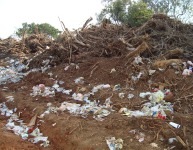 Ever since the final days of Sri Lanka’s offensive against the Tamil Tigers sent hundreds of thousands of people fleeing, aid agencies have been struggling to cope with the needs of the displaced. Add to that the operational restrictions imposed by the authorities, and it has been a challenging environment to work in.
Ever since the final days of Sri Lanka’s offensive against the Tamil Tigers sent hundreds of thousands of people fleeing, aid agencies have been struggling to cope with the needs of the displaced. Add to that the operational restrictions imposed by the authorities, and it has been a challenging environment to work in.
Not helping matters is a standoff between the government and the NGO community that is manifesting itself in the local media. Every day there seems to be an article in the newspapers with regards to what the agencies are not doing. The latest issue is the state of toilets – or lack of them – in the camps in Vavuniya.
The government says it is the United Nations and its humanitarian agency partners who are responsible for building the toilets. It may come as no surprise to some that the government is not happy with the quality and design of the toilets, which can best be described as open pit latrines with some wooden supports to cover the area. Once the pit is filled, you dig a new one somewhere else.
For reasons I am grappling to understand, most standard post-emergency operating procedures follow a process in which the initial response to a disaster is to provide ‘temporary shelters and toilets’. The next phase is the ‘transitional’ or ‘semi-permanent shelters and toilets’, and then you get to the ‘permanent shelter and toilets’.
The argument is that by building ‘temporary’ structures, people’s right to return to their homes – in itself a political issue – is reinforced. In the eyes of the agencies, anything that is built of a semi-permanent nature is tantamount to encouraging people not to return.
Critics say the problem is that agencies then end up spending almost double – by buying materials and paying labour costs to build a shelter, then paying to pull it down so that a permanent shelter can be built on the same piece of land. In the case of post-tsunami reconstruction, the cost of transitional shelters sometimes exceeded the repairs to people’s damaged houses.
POLITICISED ARGUMENT
The argument falls a little bit flat when it comes to toilets and sanitation. In displacements such as this, which involve huge numbers of people, sanitation is often the weakest link and a vicious cycle of poor sanitation, hygiene and health is perpetuated. Whatever the nature or the duration of the emergency, one issue of utmost importance is the need to ensure basic human dignity with regards to sanitation.
The government wants slightly better designed toilets which take into consideration local cultural values. However, the U.N. (and other humanitarian agencies) are concerned that by building anything deemed ‘transitional or semi-permanent’, this might ‘encourage’ the displaced to remain in the camps. This is where the confusion arises for me. Surely building a good toilet will ensure less disease? At the end of the day, I am certain that given the choice, people will not stay because their toilet facilities are better! These displaced deserve the best that they can get. This means that there should not be any compromise on the basic needs like their toilets.
(For updates you can share with your friends, follow TNN on Facebook and Twitter )
